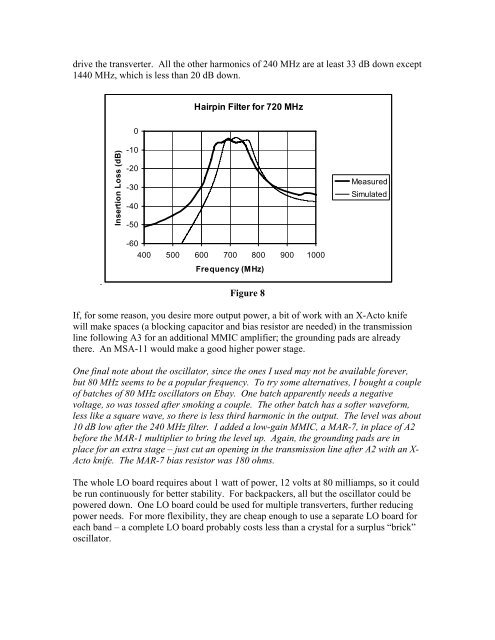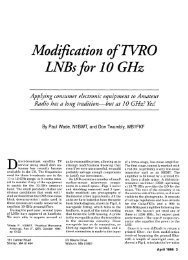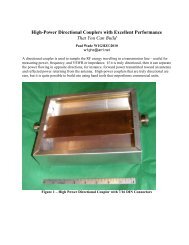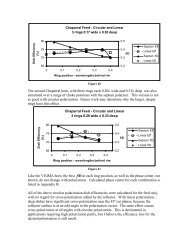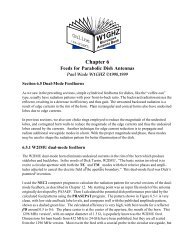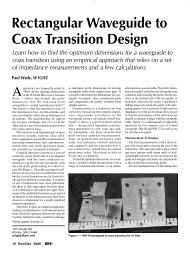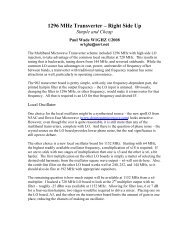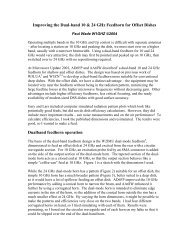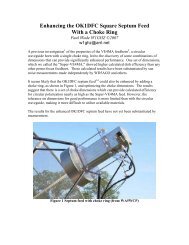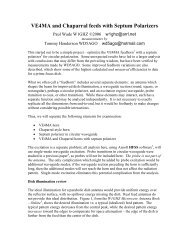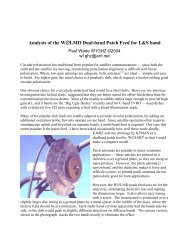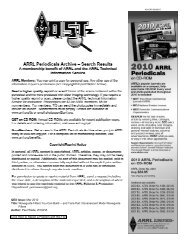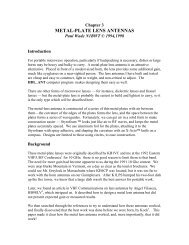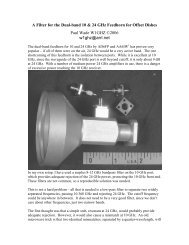Multiband Microwave Transverters for the Rover - W1GHZ
Multiband Microwave Transverters for the Rover - W1GHZ
Multiband Microwave Transverters for the Rover - W1GHZ
- No tags were found...
You also want an ePaper? Increase the reach of your titles
YUMPU automatically turns print PDFs into web optimized ePapers that Google loves.
drive <strong>the</strong> transverter. All <strong>the</strong> o<strong>the</strong>r harmonics of 240 MHz are at least 33 dB down except1440 MHz, which is less than 20 dB down.Hairpin Filter <strong>for</strong> 720 MHz0Insertion Loss (dB)-10-20-30-40-50-60400 500 600 700 800 900 1000MeasuredSimulated.Frequency (MHz)Figure 8If, <strong>for</strong> some reason, you desire more output power, a bit of work with an X-Acto knifewill make spaces (a blocking capacitor and bias resistor are needed) in <strong>the</strong> transmissionline following A3 <strong>for</strong> an additional MMIC amplifier; <strong>the</strong> grounding pads are already<strong>the</strong>re. An MSA-11 would make a good higher power stage.One final note about <strong>the</strong> oscillator, since <strong>the</strong> ones I used may not be available <strong>for</strong>ever,but 80 MHz seems to be a popular frequency. To try some alternatives, I bought a coupleof batches of 80 MHz oscillators on Ebay. One batch apparently needs a negativevoltage, so was tossed after smoking a couple. The o<strong>the</strong>r batch has a softer wave<strong>for</strong>m,less like a square wave, so <strong>the</strong>re is less third harmonic in <strong>the</strong> output. The level was about10 dB low after <strong>the</strong> 240 MHz filter. I added a low-gain MMIC, a MAR-7, in place of A2be<strong>for</strong>e <strong>the</strong> MAR-1 multiplier to bring <strong>the</strong> level up. Again, <strong>the</strong> grounding pads are inplace <strong>for</strong> an extra stage – just cut an opening in <strong>the</strong> transmission line after A2 with an X-Acto knife. The MAR-7 bias resistor was 180 ohms.The whole LO board requires about 1 watt of power, 12 volts at 80 milliamps, so it couldbe run continuously <strong>for</strong> better stability. For backpackers, all but <strong>the</strong> oscillator could bepowered down. One LO board could be used <strong>for</strong> multiple transverters, fur<strong>the</strong>r reducingpower needs. For more flexibility, <strong>the</strong>y are cheap enough to use a separate LO board <strong>for</strong>each band – a complete LO board probably costs less than a crystal <strong>for</strong> a surplus “brick”oscillator.


